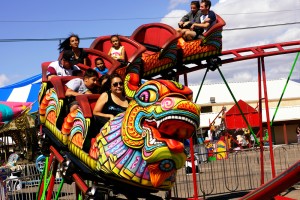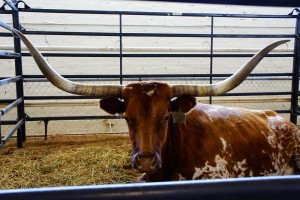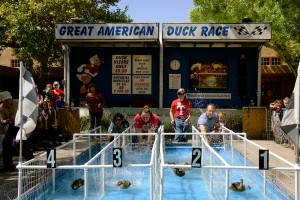Tags
Related Posts
Share This
Go Fair!
In a month filled with fiesta, few venues in New Mexico can compare in popularity and size to Albuquerque’s State Fair, running this year from Sept. 10-21. Part of EXPO New Mexico, a self-sustaining agency, the 61-year-old fair was created to “reflect and showcase” the state’s “agriculture, industries, arts, science and technology, diversity of people and traditions…and promote youth development and education.”

Need a jolt of adrenaline? Head to the New Mexico State Fair in Albuquerque for your fix on September 12, 2014.Photo by Luke E. Montavon/The Jackalope
Within the 200 annual events of EXPO New Mexico, the Albuquerque State Fair is the local favorite, providing native artists and business owners a venue to promote their work and establishments via the entertaining and food-bombarding atmosphere. This year, the fair offered its usual exhibitions and markets along the main road of Governors’ Avenue, performances and events in its Pavilion, and of course the midway carnival (complete with various-sized ferris wheels, vomit-inducing rides and marry-go-round!).
Overall, the experience can be summarized in three categories: art, animals and food.
Last weekend to visit Albuquerque’s State Fair, today through Sept. 20. As the EXPO New Mexico website reads, Go Fair!
Art
The Hispanic Arts Center, located along Avenue of the Governors, is an exhibition dedicated to Hispanic arts. This year artists submit their work in 22 visual arts categories, from traditional to contemporary, and materials included wood, straw, wax, porcelain, oil, watercolor, paper, tin, photography, wire, nails, etc. According to Cheree Bloom, art seller at this year’s Hispanic market, artists eligible for first, second, third place ribbons and honorable mentions must be at least one quarter Hispanic. Bloom says that although they go by the honor system, if any of the artists are challenged, they must present their birth certificates. This year, the submissions were judged by three residents of New Mexico, artists with degrees and an eye for what locals consider “Hispanic-themed” art.
Much of the work, for example, reflected Roman Catholic values, Southwestern culture, and the Mexican-influenced holiday Dia De Los Muertos (Day of the Dead). One section was lined with miniature statues of well known New Mexican figures like Saint Francis, La Llorona (crying lady), Saint Anthony (lost your keys? Pray to him), a curandera called “Anima La Que Sabe,” Adam and Eve (looking like Edvard Munch’s The Scream), La Reina De Mundo, and Jesus Christ with the holy family.
From across the Hispanic Arts Center stands the Native American Arts exhibit, the second popular cultural arts category of New Mexico. Like the Hispanic Arts Center, the Native American Arts exhibit displayed a variety of visual arts, but also offered hand-made jewelry, pottery, and clothes from reservations like Laguna, Pueblo, Cochiti, Acoma, Jicarilla, Jemez and Hopi.
Other art exhibitions include the African American hall, the Fine Arts Gallery, Flower Arts, and the School Arts exhibition.

A long-horn steer awaiting auction at the New Mexico State Fair in Albuquerque on September 12, 2014. Photo by Luke E. Montavon/The Jackalope
Animals
Tom McCain, president and master craftsman of the Albuquerque gallery Horny Toad Connection, inc., has been selling his collection of horny toad crafts at the fair for 29 years. “When I got out of the marine core in 1976,” McCain says, describing his animal crafts, “I made a horny toad. Everybody started telling me, uh, primarily bad jokes, but also some of the old Native Americans, Spanish and cowboys started telling me stories. I started repeated the stories and it ended up where I couldn’t sell any other animal.”
McCain’s booth, located in front of the Manuel Lujan Jr. Exhibit Complex, displays everything from bookmarks to hood ornaments. With these crafts come jokes like “if you put this horned lizard on your hood, the fellas might say, ‘there goes that horny toad.'” Overlooking the humor, McCain’s knowledge of reptile genealogy and mythology is impressive. “Well over 250 years ago,” McCain says, explaining how the creature came to its modern name, “a man came out of the East writing a wild life journal. In his journal, he got into Oklahoma and he saw the prairie species, the texas horny toad, and wrote a ‘toad or frog with many horns.’ The slippage of the english language ‘many horns’ ended up ‘horny.’ Totally misnamed because he’s actually a lizard.” Unfortunately, McCain explains, the once popular lizard of the Southwest has begun to die out. “In the urban and agricultural areas,” he says, “there are definitely almost gone.”
Inside the Manuel Lujan Jr. Exhibition Complex, the wolves and singing dogs (yes, that’s their name) visit the state fair with their protectors from the Wild Spirit Wolf Sanctuary.
“Wild animals are not pets,” says Leyton Jay Cougar, executive director of the sanctuary. When Cougar moved into a neighborhood where rare dogs were being mistreated, he began as a volunteer then in 2009 he took over as director.
The sanctuary, that works to “rescue displaced, unwanted and un-releasable captive-bred wolves, wolf-dogs, and other related species,” is operated largely by volunteers who educate the public about the dangers of treating wild animals as pets. Along with five New Guinea laughing dogs and eleven pure wolves, the sanctuary houses 43 wolf dogs, four dingos, three coyotes, one little red fox and 86 of the rarest dogs.
Food
The Agricultural Center, also located on Avenue of the Governors, is a market and exhibition of local produce and farms hosted by New Mexico’s Farmer’s Market. Along with booths informing on the future of local agriculture, the exhibitions are popular for their contests for largest grown produce in New Mexico. A pumpkin measuring 30-40 inches around, for example, or the most preserved sunflower can be seen surrounded by other abnormally large produce and children saying “look how big this squash is, mom!”
Of course, wherever you venture in the 236 acres there are numerous food and snack booths. Concessions along the main street provide the favorites- hotdogs, corn dogs, burgers, turkey legs, ice cream, popcorn, sweets, etc., but the most popular, according to State Fair Media and Communications, are inside the Villa Hispana and Indian Village. These two venues, located side by side, cook the local favorites like burritos, enchiladas, navajo tacos (sometimes called Indian tacos), bread cooked from the horno oven, funnel cakes and much more.
For more events, visit the State Fair web page.

The New Mexico State Fair is one of the few places left you can still race ducks on Friday September 12, 2014. Photo by Luke E. Montavon/The Jackalope






 Jackalope Magazine is the student magazine of Santa Fe University of Art and Design. Building on the interdisciplinary nature of our education, we aim to showcase the talent of our university and character of our city.
Jackalope Magazine is the student magazine of Santa Fe University of Art and Design. Building on the interdisciplinary nature of our education, we aim to showcase the talent of our university and character of our city.
Recent Comments